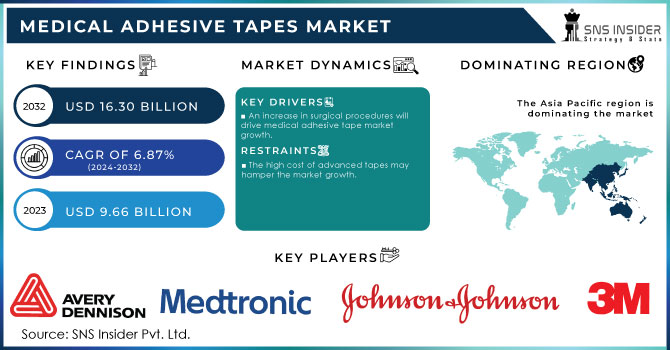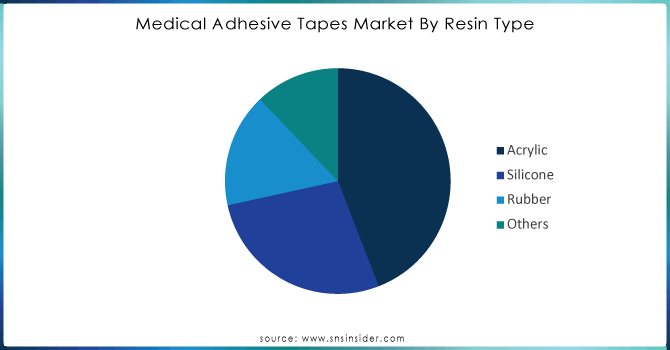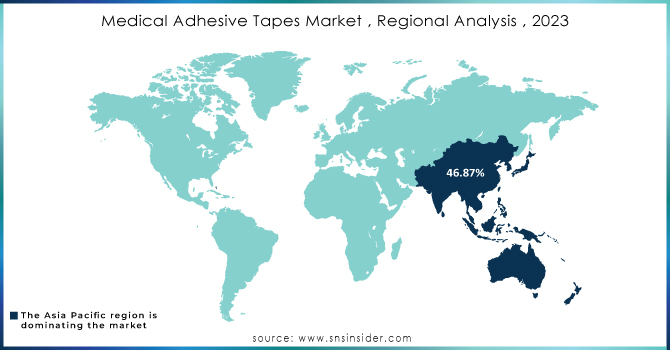Medical Adhesive Tapes Market Report Scope & Overview:
The Medical Adhesive Tapes Market Size was valued at USD 9.66 Billion in 2023 and is expected to reach USD 16.30 billion by 2032 and grow at a CAGR of 6.87% over the forecast period 2024-2032.

Get More Information on Medical Adhesive Tapes Market - Request Sample Report
The increasing understanding of the advantages of medical adhesive tape is greatly driving their use in the healthcare sector. Medical adhesive tapes are increasingly acknowledged for their convenience, dependability, and efficacy in fastening dressings, catheters, and other medical equipment. Recent developments and government statistics provide additional support for this awareness. The FDA has also given the green light to numerous newly developed medical adhesive tapes with enhanced hypoallergenic characteristics and improved sticking power, guaranteeing patient safety and comfort.
The European Medical Device Regulation that came into effect in 2021 requires more stringent safety and performance criteria, motivating manufacturers to be innovative and manufacture adhesive tapes of better quality. These regulatory and market trends are driving the uptake of medical adhesive tapes, as healthcare providers and patients are acknowledging more and more their crucial importance in effective medical care and device management.
The increasing cost of healthcare around the world is a key factor leading to the need for advanced medical products, such as adhesive tapes utilized in different medical settings. With increased investments in healthcare infrastructure by both governments and private sectors, there has been a rise in funding for innovative and efficient medical supplies. For instance, The Centers for Medicare & Medicaid Services (CMS) reported that U.S. healthcare spending reached approximately USD 4800 Billion in 2024, reflecting a significant increase in funding allocated to healthcare infrastructure and innovation.
As a result, the increase in healthcare spending directly contributes to the expansion and advancement in the market for medical adhesive tapes, addressing the changing requirements of contemporary healthcare systems.
For instance, in 2023, the European Union allocated over USD 32.82 billion in funding through the Horizon Europe program for healthcare research and innovation in 2023. This funding supports the development of advanced medical technologies, including adhesive products used in wound care and surgical applications.
Furthermore, the rising popularity of home healthcare and self-treatment is driving the need for easy-to-use medical tapes suitable for use beyond conventional medical environments. With an increase in the number of patients handling chronic illnesses and recuperating at home, there is a greater demand for medical products that are user-friendly and dependable. Factors such as the growing elderly population, increasing healthcare expenses, and improvements in telemedicine are pushing this change.
Medical Adhesive Tapes Market Dynamics:
Drivers
-
An increase in surgical procedures will drive medical adhesive tape market growth.
A rise in surgical interventions plays a major role in fueling the expansion of the medical adhesive tapes market. As the world's population gets older and chronic diseases become more common, the number of surgeries done across the globe is increasing. The World Health Organization reported that around 300 million significant surgical procedures were carried out worldwide in 2020, marking a significant rise from previous years. The increase in surgical procedures, whether planned or urgent, requires the widespread utilization of medical adhesive tapes for closing wounds, securing dressings, and fastening medical equipment. Medical adhesive tapes are crucial for postoperative care to maintain wound integrity, decrease infection risks, and ensure patient comfort. Furthermore, the market demand is also influenced by advancements in minimally invasive surgical techniques that necessitate specialized adhesive tapes. The increasing number of surgical operations highlights the urgent requirement for dependable and top-notch medical adhesive tapes, boosting their market expansion as medical professionals aim to improve surgical results and patient recovery journeys.
Restrain
-
The high cost of advanced tapes may hamper the market growth.
The expensive price of innovative medical adhesive tapes could hinder market expansion by restricting their availability and usage. Advanced adhesive tapes, with upgraded features like improved hypoallergenic formulas, stronger adhesion, and increased moisture resistance, usually come with a higher development and production cost. The increased expenses may be too expensive for smaller healthcare providers, medical facilities with limited budgets, and patients in low- and middle-income areas. Therefore, these individuals may choose cheaper but less advanced options. Moreover, the higher expenses can put pressure on healthcare funds, particularly when extensive amounts are required for continuous therapies and operations.
Medical Adhesive Tapes Market Segmentation
By Resin Type
The Acrylic held the largest market share in the type segment around 44.12% in 2023. Acrylic adhesive tapes are popular for their strong adhesion, versatility, and ability to bond with various surfaces. These tapes offer durable bonds and can withstand environmental elements like moisture and temperature changes, which makes them appropriate for different medical uses like wound dressings, surgeries, and securing medical devices.
Acrylic adhesives provide excellent breathability, essential for patient comfort and skin health, decreasing the chances of maceration and speeding up the healing process. Their hypoallergenic quality reduces the chance of allergic reactions, making them safe to use on sensitive skin. Moreover, acrylic adhesive tapes offer the capability of being easily applied to various backing materials, allowing for versatility in both product design and usage.

Get Customized Report as per your Business Requirement - Request For Customized Report
By Backing Material
In the backing material segment paper type held the largest market share around 41.63% in 2023. Paper-backed tapes are popular in various medical applications for their cost-effectiveness compared to other materials, such as for wound care and surgical procedures. The paper backing offers a seamless surface for applying adhesive and can be removed easily without leaving any residue, which is essential for ensuring patient comfort and effective wound care. Furthermore, paper-backed tapes provide excellent airflow, which aids in avoiding skin maceration and promotes healing. Their practicality is further increased by the ease with which medical information or instructions can be printed on them. The characteristics of paper-backed medical adhesive tapes have led to their significant market share in the healthcare sector as a popular and reliable choice.
By Application
In the application segment surgery segment held the largest market share around 45.63% in 2023. Surgical uses demand dependable and efficient adhesive tapes for securing dressings, managing wounds, and attaching medical devices. These tapes are necessary for upholding clean conditions, securing wounds correctly, and offering assistance throughout the healing period. Their indispensable use in the operating room comes from their strong adhesion, ability to conform to various skin types, and withstand exposure to bodily fluids. Moreover, the growing number of surgeries performed worldwide, due to reasons like the aging population and advancements in surgical methods, enhances the need for specific adhesive tapes. The surgery sector is at the forefront of the market due to the demand for long-lasting, efficient, and top-notch adhesive products in surgical environments.
Medical Adhesive Tapes Market Regional Analysis:
Asia Pacific held the largest market share in the medical adhesive tapes market about 46.87% in 2023 because of multiple important factors. The rising need for advanced medical products is growing due to increased healthcare infrastructure development in the region, supported by government and private sector investments. Moreover, the increased number of elderly individuals and the growing presence of chronic illnesses result in an increased need for medical services and related items such as adhesive tapes. The expansion of the market is also fueled by the rise of medical tourism and enhancements in healthcare accessibility in developing countries. Furthermore, the region's growing emphasis on enhancing healthcare quality and incorporating cutting-edge technologies promotes the utilization of modern medical adhesive tapes. Together, these elements contribute to a thriving and quickly expanding market for medical adhesive tapes in the Asia-Pacific area.

Key Players:
Avery Dennison Corporation (US), 3M Company (US), Johnson & Johnson (US), Medtronic PLC (Ireland) , Scapa Group PLC (UK), Nichiban Co., Ltd. (Japan), Paul Hartmann AG (Germany), Nitto Denko Corporation (Japan), Medline Industries, Inc. (US), Smith & Nephew PLC (UK), Mactac Mexico, Lohmann GmbH & Co.KG. and others.
| Report Attributes | Details |
|---|---|
| Market Size in 2023 | USD 9.66 Billion |
| Market Size by 2032 | USD 16.30 Billion |
| CAGR | CAGR of 6.87% From 2024 to 2032 |
| Base Year | 2023 |
| Forecast Period | 2024-2032 |
| Historical Data | 2020-2022 |
| Report Scope & Coverage | Market Size, Segments Analysis, Competitive Landscape, Regional Analysis, DROC & SWOT Analysis, Forecast Outlook |
| Key Segments | •By resin type (Acrylic, Silicone, Rubber, Others) •By backing material (Paper, Fabric, Plastic, Others) •By application (Surgery, Wound Dressing, Splints, Secure IV lines, Ostomy Seals, Others) |
| Regional Analysis/Coverage | North America (USA, Canada, Mexico), Europe (Germany, UK, France, Italy, Spain, Netherlands, Rest of Europe), Asia-Pacific (Japan, South Korea, China, India, Australia, Rest of Asia-Pacific), The Middle East & Africa (Israel, UAE, South Africa, Rest of Middle East & Africa), Latin America (Brazil, Argentina, Rest of Latin America) |
| Company Profiles | Avery Dennison Corporation (US), 3M Company (US), Johnson & Johnson (US), Medtronic PLC (Ireland) , Scapa Group PLC (UK), Nichiban Co., Ltd. (Japan), Paul Hartmann AG (Germany, Nitto Denko Corporation (Japan), Medline Industries, Inc. (US), Smith & Nephew PLC (UK), Mactac Mexico, Lohmann GmbH & Co.KG |
| Drivers | • An increase in surgical procedures will drive medical adhesive tape market growth. |
| Restraints | •The high cost of advanced tapes may hamper the market growth. |

